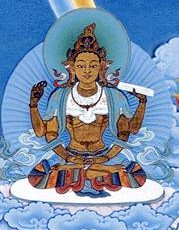「Abhisamayalankara 現觀莊嚴論」修訂間的差異
SSTC Bubble(對話 | 貢獻) 小 (已匯入 1 筆修訂) |
SSTC Serena(對話 | 貢獻) 小 (SSTC Serena 已移動頁面 Abhisamayalankara 《現觀莊嚴論》 至 Abhisamayalankara 現觀莊嚴論) |
| (未顯示同一使用者於中間所作的 1 次修訂) | |
(無差異)
| |
於 2021年3月28日 (日) 22:01 的最新修訂
Abhisamayalankara (Skt. Abhisamayālaṃkāra; Tib. མངོན་རྟོགས་རྒྱན་, Ngöntok Gyen; Wyl. mngon rtogs rgyan), The Ornament of Clear Realization — one of the five treatises that were directly revealed to Asanga by the future Buddha Maitreya, it is a commentary on the hidden meaning of the Prajñaparamita Sutras, describing the entire journey of the bodhisattva, from the generation of bodhichitta to the attainment of full omniscience. It is included among the so-called "Thirteen great texts", which form the core of the curriculum in most shedras and on which Khenpo Shenga provided commentaries.

The text is divided into eight topics:
These eight topics are further divided into seventy points.
目錄
Quotations
Definition of Bodhichitta
ཡང་དག་རྫོགས་པའི་བྱང་ཆུབ་འདོད། །
Arousing bodhicitta is: For the sake of others,
Longing to attain complete enlightenment.
Not a thing to be removed, nothing to be added
གཞག་པར་བྱ་བ་ཅུང་ཟད་མེད། །
ཡང་དག་ཉིད་ལ་ཡང་དག་ལྟ། །
In this, there is not a thing to be removed,
Nor the slightest thing to be added.
It is looking perfectly into reality itself,
And when reality is seen, complete liberation.
- Maitreya, Ornament of Clear Realization, V, 21 and Sublime Continuum, I, 154[1]
Tibetan Text
 བསྟན་བཅོས་བཞི་བརྒྱ་པ་ཞེས་བྱ་བའི་ཚིག་ལེའུར་བྱས་པ་, shes rab kyi pha rol tu phyin pa'i man ngag gi bstan bcos mngon par rtogs pa'i rgyan
བསྟན་བཅོས་བཞི་བརྒྱ་པ་ཞེས་བྱ་བའི་ཚིག་ལེའུར་བྱས་པ་, shes rab kyi pha rol tu phyin pa'i man ngag gi bstan bcos mngon par rtogs pa'i rgyan
Commentaries
Indian
- Arya Vimuktisena, Commentary on the Abhisamayalankara (Skt. abhisamayālaṅkārakārikāvārttika, Tib. ཉི་ཁྲི་སྣང་བ་, nyi khri snang ba)
 ཤེས་རབ་ཀྱི་ཕ་རོལ་ཏུ་ཕྱིན་པ་སྟོང་ཕྲག་ཉི་ཤུ་ལྔ་པའི་མན་ངག་གི་བསྟན་བཅོས་མངོན་པར་རྟོགས་པའི་རྒྱན་གྱི་ཚིག་ལེའུར་བྱས་པའི་རྣམ་པར་འགྲེལ་པ་, shes rab kyi pha rol tu phyin pa stong phrag nyi shu lnga pa'i man ngag gi bstan bcos mngon par rtogs pa'i rgyan gyi tshig le'ur byas pa'i rnam par 'grel pa
ཤེས་རབ་ཀྱི་ཕ་རོལ་ཏུ་ཕྱིན་པ་སྟོང་ཕྲག་ཉི་ཤུ་ལྔ་པའི་མན་ངག་གི་བསྟན་བཅོས་མངོན་པར་རྟོགས་པའི་རྒྱན་གྱི་ཚིག་ལེའུར་བྱས་པའི་རྣམ་པར་འགྲེལ་པ་, shes rab kyi pha rol tu phyin pa stong phrag nyi shu lnga pa'i man ngag gi bstan bcos mngon par rtogs pa'i rgyan gyi tshig le'ur byas pa'i rnam par 'grel pa
- Haribhadra, Sphutartha (Skt. Sphuṭārthā; Tib. འགྲེལ་པ་དོན་གསལ་, Wyl. 'grel pa don gsal)
Tibetan
| This section contains Tibetan script. Without proper Tibetan rendering support configured, you may see other symbols instead of Tibetan script. |
- Tsongkhapa, Golden Garland of Eloquence (ལེགས་བཤད་གསེར་ཕྲེང་, legs bshad gser phreng) (translated by Gareth Sparham, Jain Publishing, 2008)
 མངོན་རྟོགས་རྒྱན་འགྲེལ་ལེགས་བཤད་གསེར་འཕྲེང་ལས་རྣམ་པ་ཐམས་ཅད་མཁྱེན་པ་ཉིད་ཀྱི་སྐབས་, mngon rtogs rgyan 'grel legs bshad gser 'phreng las rnam pa thams cad mkhyen pa nyid kyi skabs
མངོན་རྟོགས་རྒྱན་འགྲེལ་ལེགས་བཤད་གསེར་འཕྲེང་ལས་རྣམ་པ་ཐམས་ཅད་མཁྱེན་པ་ཉིད་ཀྱི་སྐབས་, mngon rtogs rgyan 'grel legs bshad gser 'phreng las rnam pa thams cad mkhyen pa nyid kyi skabs
- Patrul Rinpoche, Overview
- Pöpa Tulku, The Oral Transmission of the Invincible Maitreya and An Adornment to the Vision of the Invincible Maitreya
 ཤེར་ཕྱིན་མངོན་པར་རྟོགས་པའི་རྒྱན་གྱི་ཚིག་དོན་རྣམ་པར་བཤད་པ་མ་ཕམ་ཞལ་ལུང་, sher phyin mngon par rtogs pa'i rgyan gyi tshig don rnam par bshad pa ma pham zhal lung
ཤེར་ཕྱིན་མངོན་པར་རྟོགས་པའི་རྒྱན་གྱི་ཚིག་དོན་རྣམ་པར་བཤད་པ་མ་ཕམ་ཞལ་ལུང་, sher phyin mngon par rtogs pa'i rgyan gyi tshig don rnam par bshad pa ma pham zhal lung ཤེར་ཕྱིན་གྱི་ཟིན་བྲིས་, sher phyin gyi zin bris
ཤེར་ཕྱིན་གྱི་ཟིན་བྲིས་, sher phyin gyi zin bris
- Amdo Geshe Jampal Rolwé Lodrö, The Essence of an Ocean of Fine Explanation
- Mipham Rinpoche ཤེར་ཕྱིན་མངོན་རྟོགས་རྒྱན་གྱི་མཆན་འགྲེལ་པུཎྜ་རི་ཀའི་དོ་ཤལ།, sher phyin mngon rtogs rgyan gyi mchan 'grel puN+Da ri ka'i do shal
 ཤེར་ཕྱིན་མངོན་རྟོགས་རྒྱན་གྱི་མཆན་འགྲེལ་པུཎྜ་རི་ཀའི་དོ་ཤལ།་, sher phyin mngon rtogs rgyan gyi mchan 'grel puN+Da ri ka'i do shal
ཤེར་ཕྱིན་མངོན་རྟོགས་རྒྱན་གྱི་མཆན་འགྲེལ་པུཎྜ་རི་ཀའི་དོ་ཤལ།་, sher phyin mngon rtogs rgyan gyi mchan 'grel puN+Da ri ka'i do shal
Translations
- Abhisamayalankara, Edward Conze (Rome: Is.M.E.O., 1954).
- Gone Beyond: The Prajnaparamita Sutras, The Ornament of Clear Realization, and Its Commentaries in the Tibetan Kagyu Tradition, Volume One, translated and introduced by Karl Brunnhölzl (Ithaca: Snow Lion), Vol. One, July 2011 / Vol. Two forthcoming 2012
- Ornament of Clear Realization: A Commentary on the Prajnaparamita of Maitreya, Thrangu Rinpoche, Zhyisil Chokyi Ghatsal, 2004.
- Abhisamayalankara (mngon rtogs rgyan), Maitreya – Asanga with commentary by Jamgön Mipham, Padmakara translation group, forthcoming
References
- ↑ This is also verse 7 of Nāgārjuna’s Heart of Dependent Origination.
Teachings Given to the Rigpa Sangha
- Dzigar Kongtrul Rinpoche – Rigpa Shedra West, Dzogchen Beara, 2003.
- Dzogchen Rinpoche – Rigpa Shedra West, Dzogchen Beara, 2004.
- Khenpo Jampal Dorje – Rigpa Shedra West, Lerab Ling, 2005.
- Khenpo Sönam Tobden - Rigpa Shedra East, 4 January to 30 April 2011.
Further Reading
- John Makransky, Buddhahood embodied: sources of controversy in India and Tibet, New York: SUNY, 1997
- James B. Apple, Stairway to Nirvana: A Study of the Twenty Samghas Based on the Works of Tsong kha pa, SUNY, 2008
- James B. Apple, Contributions to the Development and Classification of Abhisamayālaṃkāra Literature in Tibet from the Ninth to Fourteenth Centuries, JIATS, no. 5 (December 2009), available online here